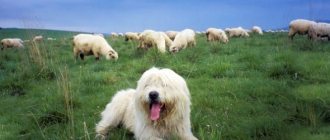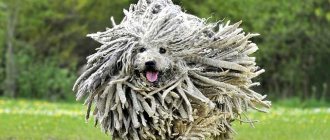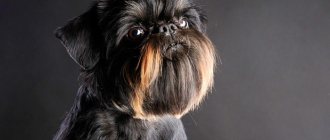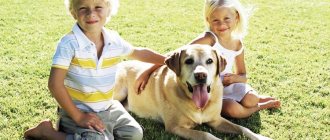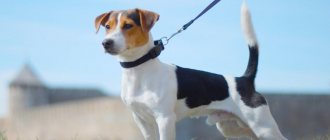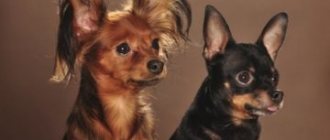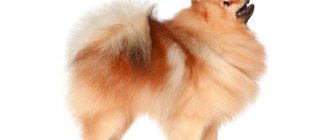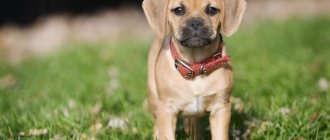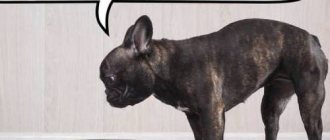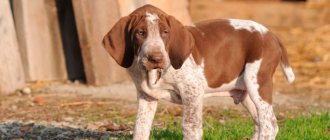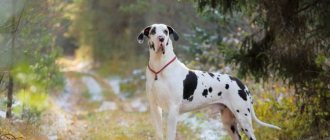This little dog looks like a sweet charmer. The Vendée Basset Griffon is a favorite dog of the whole family, especially children. The animal is docile, follows commands, and serves its owner. He is a loyal, reliable friend. But we must not forget about his hunting instincts. If you skillfully combine the characteristics of the breed, the dog will serve its owner for many years.
History of the origin of the breed
In the Middle Ages, the nobility introduced the fashion of taking hounds for hunting. The trendsetter of fashion trends not only in women's clothing, France was the leader here too. Hunting traditions flourished in it:
- All regions had their own breed of hound dogs. A large Vendeen Basset Griffon appeared in the Vendée department (France).
- Its exact origin is not known, but different versions exist. According to one of them, its origin dates back to an extinct breed of Roman hunting dogs.
- Crossbreeding over a long period has affected its original characteristics.
Many people believe that the Small Vendean Basset Griffon is similar to the Large Basset Griffon because they are descended from the same ancestors. But experts note a significant difference between them. The small griffon differs from the large one:
- Crooked paws.
- Its body and muzzle are shorter.
- The dog is much smaller in size.
1950 was the time when standards were created for both varieties, but the continuation of inbreeding dates back to 1975.
Today the Basset Griffon is the most famous French hound. By 1984, the Petit Basset Griffon Vendeen Club of America breed was created in the United States of America, and by 1992 it was supported by the United Kennel Club. Her popularity continues to grow.
Brief historical background
There are several versions of the origin of griffins. According to one of them, the ancestors of these small funny dogs were dogs called smousje, who lived in peasant farms in the vicinity of Brussels several centuries ago (14-15 centuries) and were engaged in the extermination of rodents (rats and mice), which were found in abundance in barns and granaries. The animals had a narrow, long muzzle, which helped them cope with their responsibilities better. The infusion of pug blood made them more miniature and aristocratic.
Some researchers believe that the Brussels was the result of deliberate crossing of Affen Pinschers with spaniels or wild Belgian dogs. Others believe that, on the contrary, German pinschers descended from the ancient griffons. There is an opinion suggesting the presence of an admixture of Yorkshire and Irish terrier blood. One way or another, cynologists came to an agreement in determining the exact date of the breed’s origin, believing that it appeared no later than the 30s of the 15th century. Some small dogs, extremely similar to modern Brussels griffins, were depicted on their canvases by painters of that time (Jan Van Dyck “The Arnolfini Couple”, 1434).
Artists often depicted dogs that looked like griffins in their canvases.
The first official appearance of griffons occurred in 1880 at the Brussels dog show, but they were called a little differently - the small Belgian wire-haired terrier. In 1904, the first breed standard was written and approved, which was finalized and supplemented in 1963. The latest valid version of the standard dates back to May 5, 2003, in the FCI registry Brussels Griffons are listed under No. 80 in Group 9 (Companion and Toy Dogs), Section 3 (Small Belgian Dogs).
Description of the Vendeen Basset Griffon breed
There are two varieties (small and large basset griffon). Animals were originally intended for hunting. They work both individually and together with the pack. They have a lively disposition and are energetic. Compared to the small one, the large Vendean basset griffon has long hair and tail, and the ears fall below the nose, the body is stretched, it is larger and more massive than the small one.
Size and weight
Size chart for small and large Vendeen Basset Griffon:
| Types of breed | Height at withers (males, cm) | Height at withers (females, cm) | Weight (males, kg) | Weight (females, kg) |
| Great Basset Griffon | 39-44 | 36-40 | 18-20 | 16-17 |
| Lesser Basset Griffon | 34-38 | 32-35 | 11-17 | 10-15 |
The variations in size for each individual are one centimeter.
The dog's head has the following characteristics:
- Smoothed cheekbones and frontal sulcus;
- prominent brow ridges;
- rounded forehead;
- elongated, elegant shape outlined under the eyes;
- the occipital protuberance is well developed;
Features of the muzzle:
- square shape;
- white powerful teeth with a forward bite;
- the foot does not stand out;
- the lower part is covered by jowls;
- The bridge of the nose is straight, widened or smoothly curving.
Nose:
- has a charcoal brown color;
- protruding profile;
- large in size, well developed, nostrils open.
Eyes:
- covered with overhanging eyebrows;
- the look is soft, friendly, intelligent;
- dry, close-fitting eyelids with black pigmentation;
- the cornea is dark, matching the coat color;
- round shape, medium size;
- not planted close or deep.
Ears:
- covered with guard, protruding, long, coarse hair (outside and inside);
- the cartilages at the end are rounded, elastic and thin;
- in small basset griffons no longer than the nose;
- hanging, medium in size;
- located below the eyes.
The neck is without dewlap, muscular, strong, of medium length.
Frame:
- stretched out, muscular;
- not toned stomach;
- strong, voluminous lower back;
- the chest is deep, with rounded ribs;
- straight back
Tail:
- saber-shaped, placed high, medium length, strong;
- thick at the beginning, thin towards the tip;
- the tail is located above the back;
- The hair on the tail is hard, with a thick undercoat.
Front legs:
- smooth, strong, parallel;
- well defined wrists;
- long shoulder blades set obliquely;
- powerful shoulders;
- straight, strong hind legs set wide apart;
- thighs are small, round in shape with strong muscles;
- the articulations of the corners are harmonious.
Paws:
- round shape, large;
- fingers adjacent to each other;
- Strong claws are located on springy pads.
Color and coat type
The color is varied, with fawn-colored tan marks, spotted (various shades);
Wool:
- on all parts of the body - coarse hair;
- thick undercoat;
- eyebrows, long mustache are located in the forward direction.
The skin is strong and thick, hugging the body.
Health and illness
The dog of this breed is distinguished by its strong physique and health. She did not have any pathologies noted. Other Griffon breeds suffer from herniated discs. But in this case this disease practically does not occur. Occasionally, problems related to wool occur.
Thick hair growing in the inner part of the ear falls off for a number of reasons:
- due to low ear position;
- its poor ventilation.
To prevent the disease, you must:
- Include preventive measures for cleaning the inside of the ear in your animal care system. The hairs from it must be carefully plucked, freeing the surface once a month.
- The problem comes from hair getting caught between the dog's toes. Due to its thickness, debris gets clogged in the gaps, causing injuries to the skin that lead to abscesses.
It is necessary to remove hair in these places so that debris that gets between the fingers does not provoke suppuration.
Abdominal wounds received during hunting have detrimental consequences. In such cases, the dog is placed on a blanket and immediately taken to a veterinarian.
A hunting dog is susceptible to injury due to collisions with animals. When inflicted by a wild boar, they appear on the entire body. First aid will be to apply a thick compress to the wound and immediately transport it to a veterinarian.
Lifespan
Dogs spend a huge amount of energy while chasing an animal during a hunt. This leads to rapid wear and tear of their body. But with a balanced diet and quality care, their life expectancy is from 10 to 12 years, but can last up to 17.
The main causes of death of an animal are:
- oncological diseases (33%);
- wear and tear of the body (24%);
- heart disease (7%).
In order to avoid the early death of a dog, you need to buy it only in nurseries, where animals with genetic abnormalities or poor health are culled, and healthy ones receive vaccinations and are raised properly.
Common diseases
Commonly encountered diseases include:
- infections affecting the hearing organs, including otitis media - an inflammatory process that occurs when the ears are not properly cared for;
- disruption of the thyroid gland with a decrease in the production of its hormones - hypothyroidism;
- dermatitis - due to improper hair care, when using human shampoos;
- epilepsy - congenital or acquired due to injury;
- congenital anomaly of the iris - persistent pupillary membrane.
Important! Constant activity can become a source of bruises, wounds, fractures and dislocations.
Character and intelligence
Basset Griffons need to be given daily physical and mental exercise, otherwise they will become obese and suffer from being overweight:
- They need to be taught, educated, played with, walked daily so that they are active and healthy.
- Bassets are trackers and can run away from their owner. Until the dog learns to follow commands, it should not be released from the leash.
- The dog loves to dig holes to escape, so you need to keep an eye on him.
- In addition, it will be difficult to keep basset dogs in city apartments due to their excellent vocal abilities. you will have to listen to them bark at every rustle all night, or even sing with them. These character traits of dogs need to be taken into account before purchasing a pet.
Attitude towards children and others
The Basset Griffon is an active, curious animal. He behaves friendly with people:
- If the owner warned about the approach of strangers, he will greet them.
- If children do not abuse their kindness (pulling their fur and ears), they get along well with them.
- Vendean Griffons are excellent pets and companions for their owners. Since dogs are in a pack during the hunt, they get along with other animals. But during a walk the dog will hunt them. Don't forget about its hunting instinct and keep pet hamsters and guinea pigs well.
Interesting Facts
- Aristocrats in medieval France spent a lot of time hunting, which was considered the most important entertainment for the nobility of those times. That is why, to pursue game, they so needed a medium-sized, but hardy, fast and agile dog, which the Vendean griffons became. Such hunting dogs could pursue large game, such as deer, and also easily keep up with small game, such as hares.
- Now it is difficult to accurately determine all the breeds that participated in the formation of the fleet-footed Vendeans, but it is assumed that one of their ancestors were the now extinct Roman dogs.
- Now the demand for dogs for hunting is sharply declining. But any Vendean, whose kind heart is always open to people, is capable of becoming an ideal companion for an active person, as well as becoming the favorite of some large family. After all, children can walk for a long time and play with such pets, which will certainly be useful for both.
- These dogs are said to be especially fond of chasing cyclists. This is where the hunting passion and skills of the hounds come into play.
- The Vendeans suffer greatly from lack of attention. Therefore, owners should not leave them alone in the apartment for a long time. Out of a sense of protest, they are capable of doing a lot of things, for example, making a terrible mess, chewing and tearing the owner’s clothes and furniture.
- The health of these dogs is usually good. They rarely get sick, but due to their enormous activity they often receive bruises and wounds, dislocated limbs and even fractures. In general, the short legs of Vendeen griffons are not at all an obstacle to their fast running.
Training and education
The Small and Large Vendeen Basset Griffon is a cheerful, active, intelligent dog. When training a dog, it is necessary to take into account the characteristics of its character:
- It is necessary to exclude harsh correction and screaming from educational methods.
- Reliance should be on the emotions of the owner and the dog.
- The peculiarity of the dog is that it perfectly captures the change in the owner’s mood, facial expressions and intonation of voice. The dog understands perfectly well when people admire him or are angry with him.
During training, he needs to be made aware of the correctness or incorrectness of following commands. Reprimand for unwanted actions or reward with treats for correct ones:
- During training, you cannot give him any concessions, but remain demanding. Dogs do not really like training and can pretend to be tired. It is necessary to show that the training will not stop, to bring the execution of the command to its logical conclusion.
- Classes should not be long. They need to be done frequently and short. In this case, Vandey carries out commands more clearly.
- The greatest effect comes from training started at an early age. From the age of three months, the little cunning dog has been trying to get everything from his owner. From this moment they begin to teach, educate, train him:
The first step is to establish a trusting relationship:
- The dog should sit calmly in the owner’s arms while examining the ears, teeth, and eyes.
- The animal must respond to its name. To do this, it is pronounced before feeding, before playing, or before the desire to pick up the dog.
The initial command for the baby: “Place!”, which is pronounced:
- Carrying the dog to the mat. This will help the puppy understand the meaning of the command.
- In order for the dog to learn how to do it, you need to repeatedly, after the command, put him on the bed and reward him with a treat.
During the first walk, the dog is accustomed to a leash and collar. It will not be possible to teach him to walk next to him right away. It is enough that the dog will not be afraid of them, try to gnaw them, or rush around in fear every time the leash is pulled.
There are various commands. They depend on the purpose pursued by the owner. Everyone strives to teach an animal to obey if they ask it to perform some action (come up, walk next to it, or not do something). In this case, the dog is taught to understand the meaning of the commands: “Come to me!”, “Near!”, “Ugh!”. It’s a good idea to teach your puppy general obedience commands: “Lie down!”, “Sit!” A dog participating in a show needs to know what a show rack and a ring trot are.
Start working on the command “Come to me!” needed at 3 months:
- First they say it when the dog runs to the owner.
- At 4 months you need to practice the command specifically. After a slight tug on the leash, pronounce the command. When it is completed, the dog is rewarded with a treat.
- Repeat the exercise several times, giving a treat for correct execution of the command.
You also need to use treats while teaching the “Near!” command:
- Show a piece of treat to the dog, holding it in your fist and say a command.
- After 10-15 meters you need to unclench your hand and give the dog a treat.
- Gradually increasing the distance, use a leash to correct jumping or incorrect movement.
The same technique is used when training ring trot, creating any command independently, for example: “Trotting!”
Commands "Lie down!" and “Sit!” learn using the same method. You need to show the treat, then sit or lay the dog down. After he lies down or sits down, a treat is given. The training is repeated at least five times. The correct action of the dog is accompanied by praise: “Well done!”, “Clever girl!” or other kind words.
Team "Ugh!" prohibiting. When starting to teach, they pronounce the command in a stern “growling” voice (not shouting). It is necessary to stop the violations on the part of the dog. And if the command is executed accurately, the owner praises him for it.
Many owners do not strictly follow the training method, and the dog refuses to follow commands:
- It doesn't break the sequence. First a command is given, then the animal is influenced. This cannot be done with or in front of the team.
- If the owner feels that the dog is not ready to carry out the command, there is no need to give it. Otherwise, she will understand that commands need not be followed.
- You cannot say unfamiliar commands.
- There is no need to repeat the command several times. It must be said once.
- The command must be given in different places so that the dog does not carry it out in one place.
You cannot use cruelty to a griffon, this can ruin his character. The dog will turn into a vindictive, cowardly animal, and will follow commands out of fear, and not to please the owner.
Pros and cons of the breed
Vendean Basset Griffons have many advantages:
- This hunting dog easily adapted to life in houses and apartments.
- She gets along well with her owner, following his commands with proper training, upbringing and training.
- This is a faithful friend and helper of the whole family.
- She is the protector of the home.
- She has high intelligence because she understands the owner’s mood, his gestures and facial expressions.
She understands when she is scolded and knows how to take offense. He can punish offenders and stand up for himself. In a pack of hunting dogs, she is brave and courageous.
But the dog also has disadvantages:
- Having the instinct of a hunter, he can chase mice, cats and dogs during walks.
- Finding yourself without a leash, run away from the owner without hearing his commands.
- Will come into conflict with a child who pulls her fur or ears.
- May mistake a domestic hamster and pig for game.
Therefore, after adopting a pet, you need to carefully monitor it.
Maintenance, care and nutrition
The animal can live in a house or apartment. You need to walk your dog every day, as it needs a lot of physical activity. The best conditions for this would be a house with a garden plot. The best option would be a walk in nature, where the hunting dog fully realizes its needs for movement. Much attention should be paid to the content of the animal’s fur:
- It needs to be constantly combed, and also groomed and trimmed once every 2 months so that the coat does not shed too much.
- This is also necessary because debris is retained in the hard hair shaft.
- You need to bathe your dog no more than once every 2 months.
- You need to regularly care for your animal's ears and eyes. Inspect, dry, clean the ears, pluck the fur inside them. Wipe your eyes. You should choose thorns from the wool and fight parasites.
The dog needs to be fed meat, giving it at least 200 g per day. Animals of this breed love offal. To assimilate food, they add cereal and vegetable soups, protein and plant foods. There is no need to boil dog bones.
Poor walking spoils the dog's character. She stops listening to commands, she develops bad habits and even health problems.
How to choose a puppy
Choosing a Vendeen Basset Griffon puppy for Russia is quite a difficult task, because there are not too many of them here. Only over the years does this breed begin to gain popularity. Only a few kennels are engaged in professional dog breeding in the country. On the Internet, on free advertising sites, it is extremely rare to find such an advertisement.
You need to choose a pet after talking with breeders, visiting large exhibitions, and finding out the availability of puppies of this breed in Russia. Nurseries that have the Vendeen Basset Griffon breed are located in the USA and some European countries. In Russia, the price for a puppy will be 60,000 rubles. Abroad, such a baby will cost 2,000 euros.
A Vendée Basset Griffon purchased second-hand may not be purebred, may be sick, and may not be vaccinated. Such a pet will bring more suffering than joy, especially if the gift is given to a child.
The Basset Griffon is a valuable and rare breed of dog. It is universal and can be used not only as an indoor decorative animal, which the owners have chosen as their companion. By its nature, it is an animal with a hunting instinct, which can work in a pack and engage in single combat with a large animal.
She has a high intelligence, excellent courtesy with others. But when hunting, she can be predatory and tough. The characteristics of the breed must be carefully studied before purchasing an animal. You can buy a dog only if the owner can provide it with decent care, love it and sacrifice something for its presence in the house.
Petit Basset Griffon Vendeen, PBGV
This is a small dog with short legs. The head is long with a rectangular muzzle. The nose is black or brown. The eyes are large and dark. The ears are quite long, drooping and have long hair. The neck is long. The tail is thick at the base and thin at the end. The Basset Griffon has a beard, eyebrows and mustache. Color can be white, black and white, tri-color.
- The Basset Griffon is a charming and strong dog. Training is important;
- He can be stubborn;
- This breed loves to bark.
- This dog has a lot of energy and stamina. They must train every day. They love a good long walk.
Character
A compact, hardy, lively and courageous breed, the Vendeen Basset Griffon is also active and durable. They are consistent, love to seek adventure and are very irritable and independent. This cozy breed shows great skill in hunting and is also a wonderful companion.
Temperament
The Vendeen Basset Griffon thrives and requires human companionship and attention. They are very intelligent, charming and can be quite capricious. This breed generally gets along with other dogs, but is not recommended for homes with cats or other pets; they will view them as prey. They get along with children and are somewhat friendly with strangers.
With their intelligence and desire to please, the Vendée Basset Griffon is relatively easy to train.
The breed is a bit stubborn and independent and that is why training must be firm, consistent and well balanced. Learning must be done with patience.
Early socialization and obedience training is recommended.
Common diseases
The Vendeen Basset Griffon may have the following health problems:
- pain syndrome;
- epilepsy;
- glaucoma and lens luxation;
- allergy;
- inguinal and umbilical hernias;
- luxation of the patella;
- hip dysplasia;
- hypothyroidism;
- multifocal retinal dysplasia.
